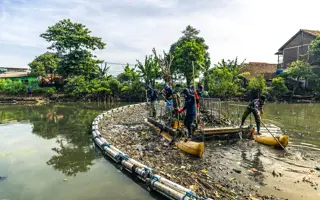News
Earth Day 2024: How 3 young engineers are tackling the plastic problem head on
In celebration of Earth Day, we are looking closer at the theme of Planet vs Plastic.

The rise of the plastic industry burst into existence in the early 20th century with the first synthetic plastic being pioneered by Leo Baekeland in 1907[1]. His invention, known as Bakelite, combined formaldehyde and phenol under heat and pressure. Bakelite had a brown, wood-like appearance which was easy to be mass-produced, bringing a consumer boom to plastic-made products.Many companies continued to experiment in creating new plastic materials.
In 1933, a company called Imperial Chemical Industries attempted to combine ethylene and benzaldehyde. Instead of achieving a hard material, a leak of oxygen created a strange, waxy substance, leading to the accidental creation of polyethylene – now the world’s most abundant plastic[2].
Modern plastics’ strong and durable properties make it a desirable material, however its inability to break down naturally has a devastating effect on the environment, ecosystems, and human health. Of the 7 billion tonnes of plastic that has been made since its creation, only 10% of it has been recycled[2]. It is also estimated that 75 – 199 million tons of plastic is currently in our oceans, meaning plastic could outweigh fish by 2025[2].
The James Dyson Award, the Foundation’s pivotal project, is a design, engineering and sustainability competition for young inventors to share solutions to global problems. Polyformer, invented by Swaleh Owais and Reiten Cheng from Canada, is a low-cost, open-source machine that converts plastic bottles into 3D filament. While working in Rwanda, they observed a lack of recycling infrastructure. As a direct result, there is a copious amount of littered plastic bottles. Alongside this, they noticed that access to basic engineering materials is limited. This inspired them to solve two problems – use waste bottles to making 3D filament more affordable.
MarinaTex, invented by Lucy Hughes from the UK, is a bioplastic alternative which is made from fish waste and red algae. The transparent film is well suited for packaging and will biodegrade in a soil environment. The organic formula does not leach harmful chemicals and can be consumed, causing no harm to wildlife or humans.
TrashBoom, invented by Moritz Schulz from Germany, is a scalable, floating barrier stops plastic waste in rivers, preventing it from flowing into the ocean. The design is low-tech and open-source which means that TrashBoom is operational worldwide, helping to reduce the growing issue of ocean plastic pollution.
Find out about other James Dyson Award winners
Sources
[1] The Age of Plastic: From Parkesine to pollution | Science Museum
